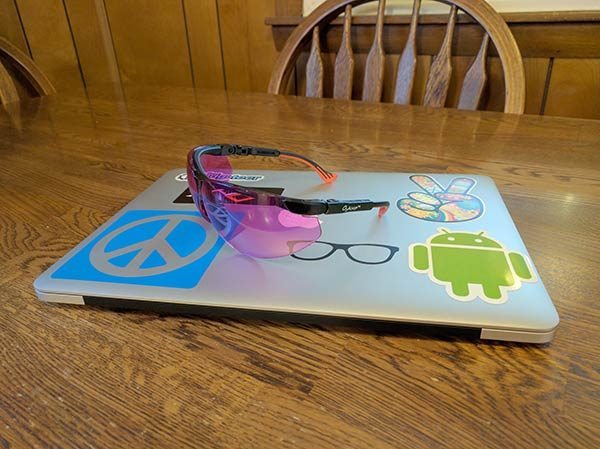
Did you know that as many as 8% of men and .5% of women who have Northern European ancestry have the most common form of red-green color blindness? What does it mean to be color blind and if you have this condition, can the Oxy-Iso color blind glasses from Vino Optics help you? Keep reading to find out.
What is color blindness and what causes it?
Most of us share a common color vision sensory experience. Some people, however, have a color vision deficiency, which means their perception of colors is different from what most of us see. The most severe forms of these deficiencies are referred to as color blindness. People with color blindness aren’t aware of differences among colors that are obvious to the rest of us. People who don’t have the more severe types of color blindness may not even be aware of their condition unless they’re tested in a clinic or laboratory.
Inherited color blindness is caused by abnormal photopigments. These color-detecting molecules are located in cone-shaped cells within the retina, called cone cells. In humans, several genes are needed for the body to make photopigments, and defects in these genes can lead to color blindness.
There are three main kinds of color blindness, based on photopigment defects in the three different kinds of cones that respond to blue, green, and red light. Red-green color blindness is the most common, followed by blue-yellow color blindness. A complete absence of color vision —total color blindness – is rare.
Source: Facts about Color Blindness – National Eye Institute (NIH)
What are Vino Optics Color Blind Glasses?
They are special glasses that were originally designed to help doctors, paramedics, nurses, etc. with red-green color blindness to see health signs like veins. The lenses in the glasses amplify the perception of oxygenation of blood under the skin, allowing color deficients better perception of veins, erythema, and other health states.
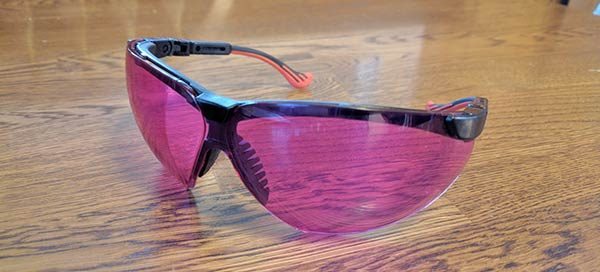
Except for the deep pink or purple-tinged lenses, the glasses don’t appear to be that special.
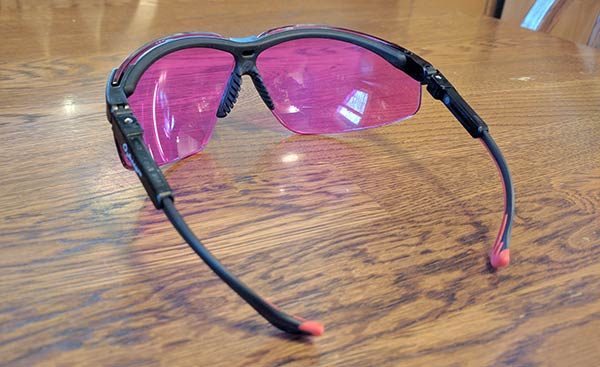
They have a plastic frame and appear to be a relatively inexpensive pair of sunglasses.
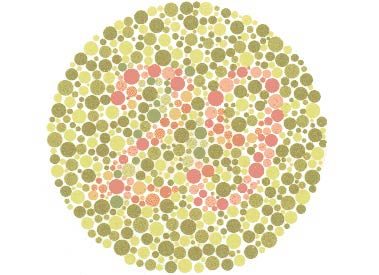
Can you see the number in the center of the circle? This is just one plate from an Ishihara Color Test. If you’re color blind you probably can’t see it. But when you put on the Vino Optics color blind glasses, you may be able to see it. I say “may” because the glasses don’t work for everyone even though the Vino Optics web site says that they can correct color blindness for everyone. I didn’t find this to be an accurate claim. Granted, I only conducted three tests with the glasses. One test with my a friend at work, one with my dad and I tested them on myself even though I’m not color blind.
I was the guinea pig for the first test and had no problems seeing every number in the Ishihara Color Test linked above. When I put on the Vino Optics glasses, the only thing I noticed was that everything had a deep pink hue and some colors like blue and yellow appeared to be brighter, almost glowing.
For the next test, I took the glasses to work and had someone who I knew was color blind take the Ishihara test. He was able to correctly guess the numbers or trace the wavy lines in only one or two of the plates, but when he put on the glasses he was able to guess almost all the plates. However, when I asked him to tell me the colors of various objects around the office, he still didn’t know the colors.
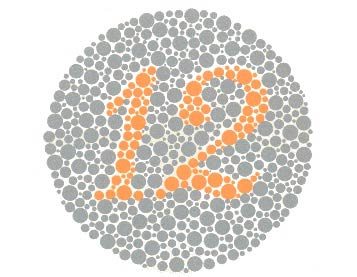
For the last test, I asked my dad to take the Ishihara test. He was only able to get one plate correct (the one pictured above). And when he put on the glasses, it did not help him guess any the numbers of any more of the Ishihara plates. He did say that some colors were brighter, but when I asked him to tell me the colors for some objects, he would say that red was brown or gray. The only color he could guess about 100% of the time was blue.
Final thoughts
Not being able to see colors seems unimaginable to me and it makes me sad to think that my dad doesn’t see things the way I do. I was hoping that the Vino Optics Oxy-Iso color blind glasses would allow my dad to experience some colors for the first time but unfortunately, they didn’t work for him. They did help my friend at work pass the Ishihara color test, but he didn’t really seem to find the world around him to be any more vibrant or exciting while wearing the glasses.
Since these glasses didn’t help my dad, I can’t recommend them for everyone who has red-green color blindness. If someone else decides to purchase a pair, let me know what you think. I hope you have better luck!
Source: The sample for this review was provided by Vino Optics. Please visit their site for more info and Amazon to order.
Color Blind Glasses for Men, Color Vision Deficiency Correcting & Enhancing Glasses for Red-Green Colour Blindness | Indoor/Outdoor Use
$79.98 (as of July 10, 2025 18:03 GMT -04:00 - More infoProduct prices and availability are accurate as of the date/time indicated and are subject to change. Any price and availability information displayed on [relevant Amazon Site(s), as applicable] at the time of purchase will apply to the purchase of this product.)BBJOZ Color Blind Glasses -Clip-on Red and Green Blindness Correction Glasses for Outdoor and Indoor Use(Only for Red-green Color Blindness)
$44.99 (as of July 10, 2025 18:03 GMT -04:00 - More infoProduct prices and availability are accurate as of the date/time indicated and are subject to change. Any price and availability information displayed on [relevant Amazon Site(s), as applicable] at the time of purchase will apply to the purchase of this product.)Product Information
| Price: | $97.00 |
| Manufacturer: | Vino Optics |
| Retailer: | Amazon |
| Pros: |
|
| Cons: |
|



Gadgeteer Comment Policy - Please read before commenting
I’m colorblind. What’s the number in that first plate? I can faintly see the “shape” of the digit…first one looks like a 2 or 7 and the next one looks like a 0, 3, 8, 9?
I’m so colorblind…
It’s 29.
As a comment to the reviewer: There’s no way glasses could make it so you can see colors that you couldn’t otherwise see. You’d need new retinas for that. What they can do is increase contrast between colors which you can’t otherwise tell apart, enabling you to differentiate between them. So having your father see all the colors you see is impossible – but being able to tell apart things that have those colors might be.
Understood, but the Vino website and description of the product says that it “corrects red-green color blindness”. That statement is misleading. I also found it strange that the glasses did not help my dad see any of the numbers in the test.
The first plate is 29 and the second one is a 12.
As an interesting random note: I wonder how good Julie’s color vision is. Potentially, it’s *very* good. One of the genes for red-green color blindness is linked to the X-chromosome, and if you only have *one* copy, it leads to being able to distinguish different colors of green that the rest of us don’t see.
Are you saying that because my dad is red-green color blind that I may see more shades of green than someone who doesn’t have a parent who is color blind? That is interesting. And it may be why green and blue are my favorite colors.
My experience is that there are varying degrees of color blindness. Some people can’t tell between red/green at all, others can see the difference between bright green and bright red. I once designed a LabView screen with mellow green and red for stop and go buttons. The lab manager changed them to neon green and bright red when I wasn’t looking, telling that he was “color impaired”. I think these glasses are for color “impaired” people, not people who are completely color blind.